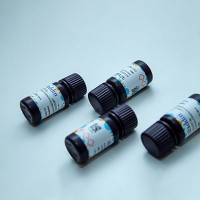活体细胞内pH值双光子成像技术
互联网
本文由丁香园站友 photomedicine 转载并编译,点此查看详情
细胞内PH值现在可以通过蛋白质的红色荧光成像来测量。
美国哈佛大学医学院神经生物学系Gary Yellen等研究者最近研发了基因编码的红色荧光蛋白质pHRed在活体细胞内成像pH值的技术。采用一般条件下采用440纳米激发光或者在酸性环境下采用585纳米激发光可以获得不同的荧光读数,根据两个激发光获得荧光读数的比例就可以读出细胞内PH值。
pHRed的荧光寿命(从光激发到荧光发射的时间)也跟pH值有关。作者根据这个特性,采用双光子显微镜可以一秒一秒地跟着活体细胞内pH值变化。
作者采用红色荧光探针,为多颜色多通道成像研究保留了绿色荧光波长的通道作为其他细胞特性的研究(如能量代谢等)。
参考文献:J. Am. Chem. Soc. doi:10.1021/ja202902d (2011)
原文内容:
Nature News: A microscopist’s litmus test
Jun 23, 2011 Vol.474
Intracellular pH levels can now be measured with a protein that glows red.
The red fluorescent protein has been dubbed pHRed by its designers, Gary Yellen and his colleagues at Harvard Medical School in Boston, Massachusetts. Light-detecting molecules of pHRed are preferentially excited by light at a wavelength of either 440 nanometres in basic conditions or 585 nanometres in acidic conditions, and the excitation ratio of the two gives a read-out of pH.
pHRed’s fluorescence lifetime — the time between excitation and emission — also responds to pH. The authors used this feature in two-photon microscopy to track second-by-second pH changes in living cells.
A red pH sensor leaves the often-used green fluorescence wavelength available for simultaneous study of other cellular properties, such as energy metabolism, during multicolour imaging.
Reference: J. Am. Chem. Soc. doi:10.1021/ja202902d (2011)



![2,4-二氯-1-萘酚[用于照相技术],2050-76-2,≥97%(GC)(T),阿拉丁](https://img1.dxycdn.com/p/s14/2024/0619/923/2131019441498633081.jpg!wh200)



